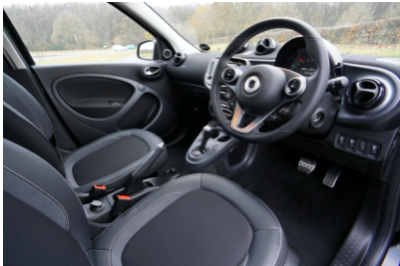Cleaning A Car Interior
Let’s be honest –– how long has it been since you got to enjoy the feeling of a clean car seat?
Most drivers clock an average mileage of 20,000 km per year, which means that the typical driver often spends an hour or two behind the wheel daily. Imagine the hundreds of times your car doors have opened, windows been rolled down, and sweaty passengers being carried… nasty, isn’t it?
That’s why cleaning your car interior is crucial in maintaining cleanliness and value. Though it won’t bring back the feeling of a brand-new car seat, it does a good job of improving the air quality and hygiene of your car. Plus, you’re able to save hundreds of dollars on professional detailing by doing it yourself!

How Often Should I Clean My Car Interior?
The frequency and intensity of cleaning a car’s interior differ from driver to driver –– rather, it’s dependent on your driving conditions, how frequently you drive, the number of passengers you carry, and how the vehicle is used.
Here’s what you’ll need: a trash bag, dishwashing liquid, disinfecting wipes, paper towel, water, ammonia-free window cleaner or distilled white vinegar, and baking soda. Alternatively, you may want to consider purchasing oxygen-based bleach, upholstery cleaner, or a leather cleaner for a cleaner job. You’ll also need to have these tools on hand: a bucket, duster, old toothbrush, sponge, cotton swab, microfiber cloths, a vacuum with hose attachments, and a garden hose (optional). Sometimes you’ll find it easier to just replace certain parts, like car mats. If that happens, just get a new one at https://simplycarmats.co.uk/. With that being said, let’s break down the different procedures to clean a car’s interior.
Step-By-Step Procedure
1. Decluttering The Car
Before attempting to clean your car interior, you should begin by gathering all your rubbish from the cup holders, floorboards, and door and seat pockets. Do remember to remove all additional items left behind in the car –– such as toys, gym bags, car seats, water bottles. If you’re planning on disposing of the rubbish, remember to bring a garbage bag in advance. Remember to don the appropriate safety gear; you don’t want to get your hands unnecessarily dirty, especially if you’re dealing with unpleasant garbage! Additionally, do consider bringing a recycling container along, where you can sort and place all recyclables –– such as cardboard items, plastic bottles, and paper –– into a separate section for recycling.
2. Remove and Clean Floor Mats
The floor mats are undoubtedly one of the messiest components of the car and accumulate the most dirt. Before you begin vacuuming, you should remove the floor mats and shake it out to help reveal the grime underneath. Different floor mats would require different forms of cleaning techniques; for example, carpeted mats would need a carpet or upholstery cleaner, whereas rubber, vinyl, or silicone mats only require a good hosing down. This includes creating a soapy water combination of a few drops of dishwashing liquid and warm water, and dip a scrub brush to clean the silicone or rubber mats. Once you’re done washing the mats, leave them out to air-dry before placing them back into the vehicle.
3. Cleaning The Interior Windows and Mirror
Wet a microfiber towel lightly with an ammonia-free window cleaner to get rid of the haze from interior windows. It’s important to use a microfibre towel, as they are specially designed to remove tough stains whilst avoiding streaking. Additionally, choosing an ammonia-free window cleaner is important as ammonia could potentially dry out the plastic in your vehicle and damage the windows.
Start by lowering your windows and cleaning from the top to bottom systematically, to double-check the label of the cleaning product to make sure that it is safe to use.
4. Cleaning The Center Console
The center console is often used to hold cup holders, which results in it getting messy and dirty easily. Soak the cup holder in warm water and dishwashing liquid to remove stains, and rinse it with fresh water after. To finish, dry it with a cloth and reassemble the console.
When cleaning the joystick and controls, dampen a clean microfiber cloth slightly with a household cleaner, and work from the cleanest areas to the dirtiest –– for example, you can start with the centre console, before working your way to the gearstick. Hint: use an old toothbrush or damp cotton swab to reach every nook and cranny!

5. Wiping the Dashboard And Door Panels
One trick is to use a duster to remove the majority of the dirt from the dashboard, and use cotton swabs to reach the tight spaces around the vents and knobs. Similarly, use a damp microfiber cloth with a household cleaner to wipe down the door panels, and make sure to not leave residue behind. In both cases, it’s good to repeat the cleaning process by going over the cleaned areas with another damp, clean microfiber –– this helps to pick up any residual grime and remove fingerprints.
6. Disinfect Steering Wheel
Use a clean microfiber cloth or disinfecting wipes to wipe down the steering wheel and gear shift knobs. If you have trouble removing stains, consider switching to cotton buds to reach tight corners. It’s important to change to a clean cloth every once in a while, as you might be transmitting the mess you’ve cleaned up to the next person.
7. Tackling The Car Seats
Your cleaning method is dependent on the texture of your car seat, as different materials require specific forms of care. For example, to avoid cracking, leather car seats require a vacuum crevice tool and an appropriate cleaner (eg. saddle soap) to remove dust and grime. Alternatively, you can consider conditioning the seats to restore its shine and suppleness.
To clean heavily-stained cloth car seats, you’ll need to have an appropriate upholstery cleaner or know specific strain treatment methods. Dye-based stains, such as Kool-Aid, can be removed by a combination of water and oxygen-based bleach. Rub the paste into the stained area and leave it for an hour –– the stains should be (almost) fully removed! After removing all the stains, use a scrub brush to apply cleaner to the fabric, and wipe it again with a damp microfiber cloth.
Don’t forget to clean your seat belts as well! Wipe the fabric straps with an upholstery cleaner to remove external dirt, and use a microfiber cloth to clean the metal fasteners and molded claps.

8. Vacuum the Car
We’re almost there, so hang on! Make sure that you all have the required items: upholstery nozzle, crevice vacuum cleaner tool, and a dusting brush. Each part of the car would require using different cleaning technologies –– for example, upholstered areas (eg. ceiling, seats) require the upholstery nozzle. By saving this to the last, we’re able to focus on getting rid of all the debris from the previous tasks. However, if there are large stains prevalent on the carpet, we can begin by searching where the commercial carpet cleaner is advised.
9. Getting Rid of Odors
Did you know that you’re able to control odours, just by combining baking soda and activities charcoal in a sealed plastic container? You’ll only need to change the containers monthly, and ensure that there are slits in the lid, and place it below the seats. Otherwise, you can opt to sprinkle the car seats and carpet with dry baking soda to get rid of any stale or stuffy odour. Let these substances sit in the car overnight before vacuuming it away; you’ll soon observe a big change in terms of odour!
Conclusion
For regular drivers, a good clean every six to eight months is sufficient enough to maintain the ‘new’ look and feel of a vehicle. However, first-timers should beware –– be prepared to take a significantly longer time, especially if it has not been cleaned in a while.
One man’s car is another man’s scenery, hence having regular vehicle maintenance can help to increase its resale value by hundreds and thousands of extra dollars in the future.




























































